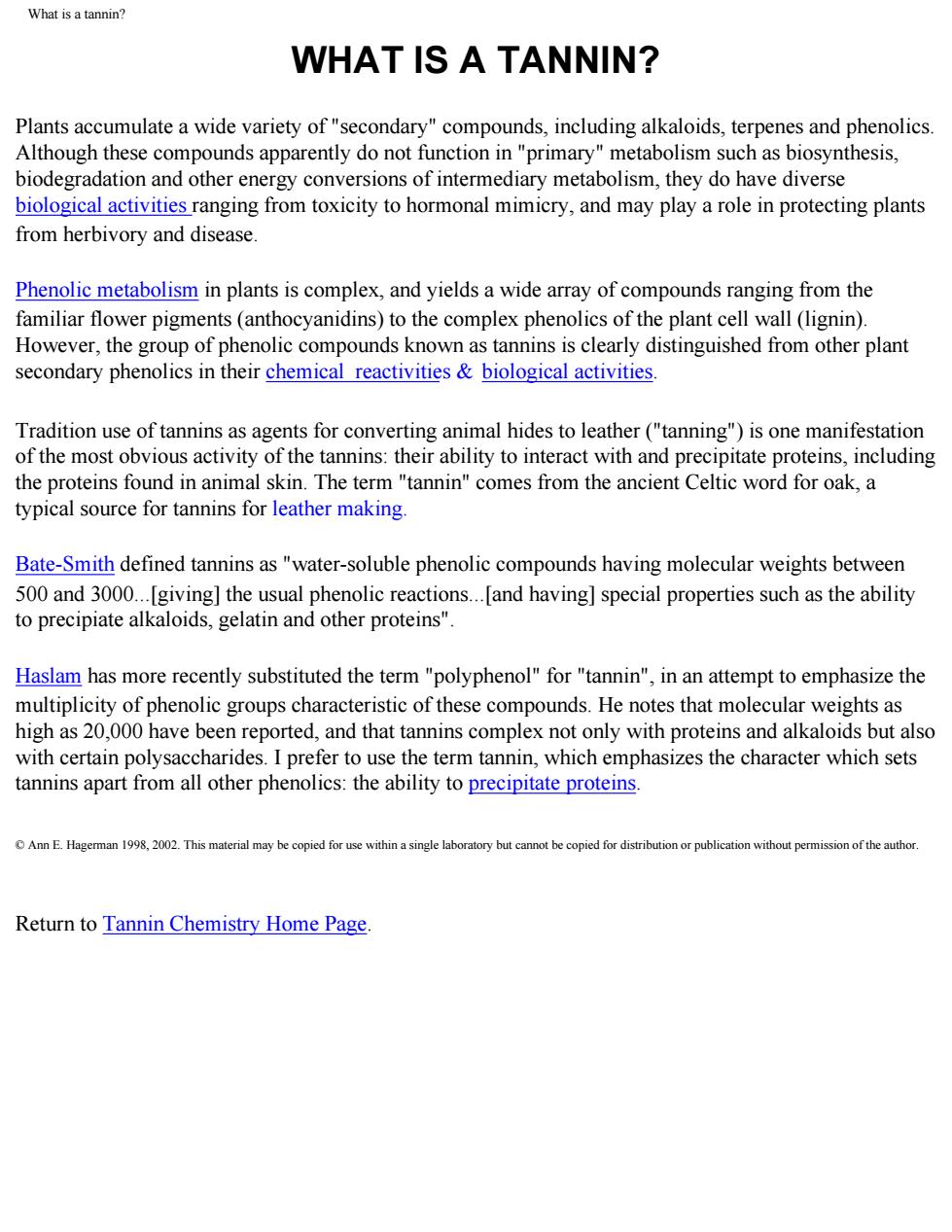正在加载图片...

What is a tannin? WHAT IS A TANNIN? Plants accumulate a wide variety of"secondary"compounds,including alkaloids,terpenes and phenolics Although these compounds apparently do not function in "primary"metabolism such as biosynthesis, biodegradation and other energy conversions of intermediary metabolism,they do have diverse biological activities ranging from toxicity to hormonal mimicry,and may play a role in protecting plants from herbivory and disease Phenolic metabolism in plants is complex,and yields a wide array of compounds ranging from the familiar flower pigments(anthocyanidins)to the complex phenolics of the plant cell wall(lignin). However,the group of phenolic compounds known as tannins is clearly distinguished from other plant secondary phenolics in their chemical reactivities biological activities. Tradition use of tannins as agents for converting animal hides to leather("tanning")is one manifestation of the most obvious activity of the tannins:their ability to interact with and precipitate proteins,including the proteins found in animal skin.The term"tannin"comes from the ancient Celtic word for oak,a typical source for tannins for leather making Bate-Smith defined tannins as "water-soluble phenolic compounds having molecular weights between 500 and 3000...[giving]the usual phenolic reactions...[and having]special properties such as the ability to precipiate alkaloids,gelatin and other proteins" Haslam has more recently substituted the term"polyphenol"for"tannin",in an attempt to emphasize the multiplicity of phenolic groups characteristic of these compounds.He notes that molecular weights as high as 20,000 have been reported,and that tannins complex not only with proteins and alkaloids but also with certain polysaccharides.I prefer to use the term tannin,which emphasizes the character which sets tannins apart from all other phenolics:the ability to precipitate proteins. Ann E.Hagerman 1998,2002.This material may be copied for use within a single laboratory but cannot be copied for distribution or publication without permission of the author Return to Tannin Chemistry Home PageWhat is a tannin? WHAT IS A TANNIN? Plants accumulate a wide variety of "secondary" compounds, including alkaloids, terpenes and phenolics. Although these compounds apparently do not function in "primary" metabolism such as biosynthesis, biodegradation and other energy conversions of intermediary metabolism, they do have diverse biological activities ranging from toxicity to hormonal mimicry, and may play a role in protecting plants from herbivory and disease. Phenolic metabolism in plants is complex, and yields a wide array of compounds ranging from the familiar flower pigments (anthocyanidins) to the complex phenolics of the plant cell wall (lignin). However, the group of phenolic compounds known as tannins is clearly distinguished from other plant secondary phenolics in their chemical reactivities & biological activities. Tradition use of tannins as agents for converting animal hides to leather ("tanning") is one manifestation of the most obvious activity of the tannins: their ability to interact with and precipitate proteins, including the proteins found in animal skin. The term "tannin" comes from the ancient Celtic word for oak, a typical source for tannins for leather making. Bate-Smith defined tannins as "water-soluble phenolic compounds having molecular weights between 500 and 3000...[giving] the usual phenolic reactions...[and having] special properties such as the ability to precipiate alkaloids, gelatin and other proteins". Haslam has more recently substituted the term "polyphenol" for "tannin", in an attempt to emphasize the multiplicity of phenolic groups characteristic of these compounds. He notes that molecular weights as high as 20,000 have been reported, and that tannins complex not only with proteins and alkaloids but also with certain polysaccharides. I prefer to use the term tannin, which emphasizes the character which sets tannins apart from all other phenolics: the ability to precipitate proteins. © Ann E. Hagerman 1998, 2002. This material may be copied for use within a single laboratory but cannot be copied for distribution or publication without permission of the author. Return to Tannin Chemistry Home Page